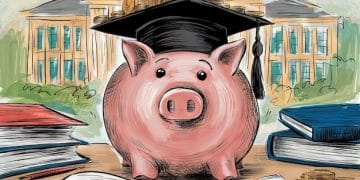New Legislation Expands Pell Grant: Impact on College Access

The new legislation aims to expand Pell Grant eligibility by 15%, which will significantly impact higher education access for low-income students by providing increased financial aid opportunities.
The landscape of higher education is poised for a significant shift as new legislation seeks to broaden Pell Grant eligibility by an estimated 15%. This initiative promises to reshape access to college for countless students, particularly those from low-income backgrounds. The expansion of **Pell Grant eligibility** could be a game-changer, offering a crucial financial lifeline and fostering greater equity in higher education.
Understanding the Pell Grant Program
The Pell Grant program stands as a cornerstone of federal financial aid, designed to help students from low-income families afford the soaring costs of higher education. Unlike loans, Pell Grants do not need to be repaid, making them an invaluable resource for those who might otherwise be priced out of college.
Administered by the U.S. Department of Education, Pell Grants are awarded based on financial need, as determined by a student’s Expected Family Contribution (EFC). These grants can be used to cover tuition, fees, and other educational expenses, providing a much-needed boost to students striving to achieve their academic goals.

Eligibility Criteria for Pell Grants
To qualify for a Pell Grant, students must meet certain eligibility requirements. These include demonstrating financial need, being a U.S. citizen or eligible non-citizen, and enrolling in an eligible degree or certificate program at a participating institution.
- Financial need is assessed based on the student’s EFC, which takes into account family income, assets, and household size.
- Students must maintain satisfactory academic progress to continue receiving Pell Grant funding.
- The maximum Pell Grant amount is adjusted annually and depends on factors such as the student’s enrollment status and the cost of attendance at their chosen institution.
The Pell Grant program’s impact extends far beyond individual students, benefiting communities and the nation as a whole by fostering a more educated and skilled workforce. The new legislation aims to widen the reach of this vital program, ensuring that more students have the opportunity to pursue their dreams of higher education.
Details of the Proposed Legislation
The heart of this issue lies in the specifics of the proposed legislation and its potential ripple effects on the higher education system. Designed to tackle issues of access and affordability, the bill aims to increase college enrollment and completion rates among underserved populations.
The proposed legislative changes focus on key areas such as simplifying the application process, increasing the maximum Pell Grant award, and expanding eligibility criteria to include more students. By streamlining the process and making more funds available, lawmakers hope to remove barriers that prevent qualified students from pursuing higher education.
Key Provisions of the Bill
The legislation includes several key provisions that could significantly alter the landscape of financial aid. These provisions range from expanding eligibility to increasing grant amounts.
- Increase in Maximum Pell Grant Award: The bill proposes raising the maximum Pell Grant award by a specific dollar amount, providing students with more financial assistance to cover tuition and other expenses.
- Expansion of Eligibility Criteria: The legislation seeks to broaden eligibility criteria to include more low-income and middle-income students who currently do not qualify for Pell Grants.
- Simplification of Application Process: The bill aims to simplify the Free Application for Federal Student Aid (FAFSA) process, making it easier for students and families to apply for financial aid.
Furthermore, advocates emphasize that investment in education is an investment in the future. By expanding access to higher education, the nation can cultivate a more skilled and competitive workforce, driving economic growth and innovation.

Impact on Higher Education Institutions
The proposed expansion of Pell Grant eligibility is expected to have a profound impact on colleges and universities across the United States. As more students become eligible for financial aid, institutions may see an increase in enrollment, particularly among students from low-income backgrounds.
This influx of Pell Grant recipients could lead to greater diversity on campuses, enriching the educational experience for all students. However, it may also require institutions to adapt their services and resources to better support the needs of a more diverse student body.
Potential Challenges for Institutions
While the expansion of Pell Grant eligibility presents numerous opportunities, it also poses potential challenges for higher education institutions. These challenges range from financial considerations to the need for enhanced support services.
Ensuring that adequate resources are available to support Pell Grant recipients, such as advising, tutoring, and career counseling, will be crucial for helping these students succeed. Some institutions may need to invest in additional staff and programs to meet the needs of a growing population of Pell Grant recipients.
The legislation could also incentivize institutions to focus on student outcomes, such as graduation rates and job placement, as they become more accountable for the success of Pell Grant recipients. By aligning incentives with student success, the new legislation could drive improvements in institutional quality and effectiveness.
The Broader Economic Implications
Beyond the immediate impact on students and educational institutions, the proposed expansion of Pell Grant eligibility carries significant implications for the broader economy. By increasing access to higher education, the legislation has the potential to boost economic growth, reduce income inequality, and enhance social mobility.
Studies have consistently shown that individuals with college degrees earn more over their lifetimes, are less likely to be unemployed, and contribute more to the tax base. By making college more affordable for low-income students, the expansion of Pell Grant eligibility can help break the cycle of poverty and create a more equitable society.
The ripple effects of a more educated workforce could be felt across various sectors of the economy, from healthcare and technology to manufacturing and finance. A more skilled workforce can drive innovation, increase productivity, and enhance global competitiveness.
Long-Term Economic Benefits
The long-term economic benefits of the proposed legislation extend far beyond individual earnings and tax revenues. A more educated population is also more likely to be engaged in civic life, participate in community organizations, and contribute to the common good.
Moreover, access to higher education can empower individuals to pursue their passions, develop their talents, and make meaningful contributions to society. By fostering a culture of lifelong learning, the expansion of Pell Grant eligibility can help create a more vibrant and prosperous nation.
The expansion of Pell Grant eligibility represents a strategic investment in the future, one that promises to pay dividends for generations to come. By unlocking the potential of millions of students, the nation can build a stronger, more inclusive, and more competitive economy.
Criticisms and Potential Drawbacks
While the proposed expansion of Pell Grant eligibility has garnered widespread support, it has also faced criticism from some quarters who worry about the costs and potential drawbacks of such a significant increase in federal spending.
Concerns have been raised about the potential for increased tuition rates, as institutions may seek to capture a portion of the additional Pell Grant funds. Some critics also argue that expanding eligibility could dilute the value of the Pell Grant, making it less effective in helping the neediest students.
Addressing Concerns and Mitigating Risks
Lawmakers and policymakers are working to address these concerns and mitigate potential risks through various safeguards and oversight measures. These include capping tuition increases, strengthening accountability standards for institutions, and targeting Pell Grant funds to the neediest students.
- Implementing tuition caps to prevent institutions from excessively raising tuition rates in response to the expansion of Pell Grant eligibility.
- Strengthening accountability standards for institutions to ensure that they are providing a high-quality education to Pell Grant recipients and helping them succeed.
- Targeting Pell Grant funds to the neediest students by adjusting eligibility criteria and prioritizing those with the greatest financial need.
Advocates emphasize that the benefits of expanding Pell Grant eligibility far outweigh the potential risks and costs. By investing in higher education, the nation can create a brighter future for millions of Americans and build a stronger, more prosperous society.
Personal Stories: The Human Impact
Behind the statistics and policy debates are real people whose lives could be transformed by the proposed expansion of Pell Grant eligibility. Hearing their stories can provide a powerful reminder of the human impact of this legislation.
Consider the story of Maria, a first-generation college student from a low-income family who dreams of becoming a nurse. Currently, she works multiple part-time jobs to support herself and help her family, leaving little time for studying. A Pell Grant would allow her to focus on her studies, complete her degree, and pursue her passion for helping others.
Real People, Real Dreams
The expansion of Pell Grant eligibility can empower individuals like Maria to achieve their dreams and transform their lives and the lives of their families. By providing access to higher education, the legislation can unlock the potential of millions of Americans.
- Pell Grants can reduce the need for students to work long hours, allowing them to focus on their studies and improve their academic performance.
- Access to higher education can lead to higher earnings, better job opportunities, and greater financial security for Pell Grant recipients and their families.
- Pell Grants can help break the cycle of poverty by providing low-income individuals with the skills and knowledge they need to succeed in the 21st-century economy.
The proposed expansion of Pell Grant eligibility is not just about numbers and policies; it’s about people and their dreams. By investing in higher education, the nation can invest in its future and create a more equitable and prosperous society for all.
| Key Point | Brief Description |
|---|---|
| 🎓 Expanded Eligibility | More students, especially from low-income backgrounds, qualify. |
| 💰 Increased Grant Amount | Higher maximum awards to ease financial burden. |
| 🏢 Impact on Institutions | Colleges may see increased enrollment and diversity. |
| 📈 Economic Boost | A more educated workforce can drive economic growth. |
Frequently Asked Questions (FAQ)
▼
The Pell Grant is a federal financial aid program that provides grants to students with financial need to help them pay for college. Unlike loans, Pell Grants do not need to be repaid.
▼
Eligibility is primarily based on financial need, determined by the student’s Expected Family Contribution (EFC). Students must also be U.S. citizens or eligible non-citizens and enrolled in an eligible program.
▼
The legislation aims to broaden eligibility by increasing the income thresholds for qualifying. This provides more low-income and middle-income students the financial aid opportunities when pursuing higher education.
▼
Yes, the bill proposes to increase the maximum Pell Grant award. The specific amount of the increase is subject to legislative debate, but it aims to alleviate tuition costs.
▼
Colleges and universities may experience increased enrollment, therefore increasing diversity. Though additional support may be needed to help Pell Grant recipients succeed, increased funding helps.
Conclusion
In summary, the proposed expansion of





